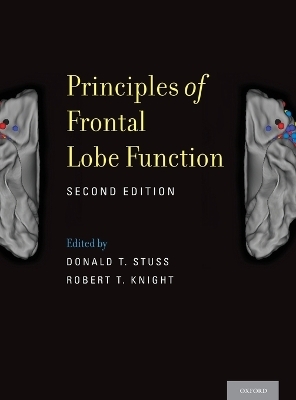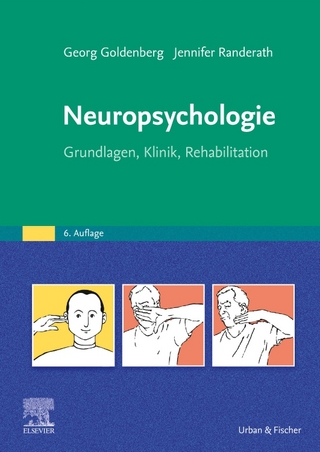
Principles of Frontal Lobe Function
Oxford University Press Inc (Verlag)
978-0-19-983775-5 (ISBN)
The second edition of Principles of Frontal Lobe Function is a newly organized, and thoroughly updated, volume divided into 9 different sections, each co-edited by leaders in the specific domain of frontal lobe research. The topic areas include anatomy and neuropharmacology, development, systems and models, fundamental cognitive mechanisms, social behavior, clinical neuropsychology, aging, psychiatric disorders, and rehabilitation. This organization reflects both an increase in our combined knowledge about frontal lobe functioning through new imaging technologies, as well as the expansion of the field as a whole to include new topics such as social neuroscience that were not discussed in the first edition.
Principles of Frontal Lobe Function will naturally be of particular interest to researchers and clinicians actively investigating how the frontal lobes operate and to understand dysfunction as a means to design treatment. This new edition will also be a useful resource for anyone involved in a discipline related to brain function, whether it be cognitive neuroscience, behavioral neurology, neuropsychiatry, neuropsychology, or neurorehabilitation. Our knowledge of how the frontal lobes are integrated with functioning in every other region of the brain is also integrating our approach to solving brain-based problems.
Authors in this volume represent investigators who are deep-rooted in frontal lobe research. As such, students will be exposed to both the classical and frontier perspectives and will gain significant insight into future research directions of what we believe to be the most fascinating area of the brain.
Donald T. Stuss, Ph.D., C. Psych., ABPP-CN, Order of Ontario, FRSC, FCAHS, is the founding (2011) President and Scientific Director of the Ontario Brain Institute; a Senior Scientist at the Rotman Research Institute of Baycrest Centre; University of Toronto Professor of Medicine (Neurology and Rehabilitation Science) and Psychology; founding Director of the Rotman Research Institute 1989 - 2008. His research focuses on understanding and treating the cognitive functions and personality changes associated with the frontal lobes as they occur after stroke, normal elderly, and in those with traumatic brain injury or dementia. He has one co-authored book, and four co-edited books; over 190 publications and 48 chapters; and presented over 250 invited scientific lectures and workshops. Robert T. Knight, MD, received a degree in Physics from the Illinois Institute of Technology, an MD from Northwestern University Medical School, obtained Neurology training at UCSD and did post-doctoral work at the Salk Institute for Biological Studies. He was a faculty member in the Department of Neurology at UC Davis School of Medicine from 1980-1998 and moved to UC Berkeley in 1998 serving as Director of the Helen Wills Neuroscience Institute from 2001 until 2011. His laboratory utilizes electrophysiological techniques in neurological and neurosurgical patients to delineate the role of prefrontal cortex in human cognitive. His laboratory also records electrocorticographic activity from neurosurgical patients with subdural electrodes to delineate cortical mechanisms of behavior as well as for development of neural prosthesis for motor and language restoration. He founded the UC Berkeley-UCSF Center for Neural Engineering and Prosthesis in 2010.
1. Donald T. Stuss and Robert T. Knight ; Introduction: Past and Future ; 2. Joaquin M. Fuster ; Cognitive Functions of the Prefrontal Cortex ; SECTION I: NEUROANATOMY and NEUROPHARMACOLOGY ; Introduction to Section I: Helen Barbas & Trevor Robbins ; 3. Helen Barbas, Jamie G. Bunce, & Maria Medalla ; Prefrontal Pathways that Control Attention ; 4. Amy F.T. Arnsten ; Fleeting Thoughts: Molecular Vulnerabilities in Prefrontal Cortical Circuits ; 5. Trevor W. Robbins ; Optimising the Executive: Neurochemical Modulation of the Fronto-Executive 'Toolbox' ; 6. Jonathan D. Wallis & Steven W. Kennerley ; The Functional Role of Reward Signals in Different Prefrontal Areas ; 7. Michael Petrides ; The Mid-Dorsolateral Prefronto-Parietal Network and the Epoptic Process ; SECTION II: FRONTAL LOBE DEVELOPMENT ; Introduction to Section II: Silvia Bunge and Arthur Toga ; 8. David A. Lewis & Darlene Melchitzky ; Postnatal Development of Neural Circuits in the Primate Prefrontal Cortex ; 9. Vicki Anderson & Megan Spencer-Smith ; Children's Frontal Lobes: No Longer Silent? ; 10. Jay N. Giedd, Armin Raznahan, & Rhoshel K. Lenroot ; Adolescent Frontal Lobes: Under Construction ; 11. Allyson P. Mackey, Rajeev D.S. Raizada, Silvia A. Bunge ; Environmental Influences on Prefrontal Development ; 12. Jessica A. Church, Steven E. Petersen, & Bradley L. Schlaggar ; Development of Cortical Networks for Top-Down Control ; 13. Kai Hwang & Beatriz Luna ; The Development of Brain Connectivity Supporting Prefrontal Cortical Functions ; 14. Yuko Munakata, Christopher H. Chatham, & Hannah R. Snyder ; Mechanistic Accounts of Frontal Lobe Development ; SECTION III: SYSTEMS/MODELING ; Introduction to Section III: Earl Miller and Masataka Watanabe ; 15. Masataka Watanabe ; How Context Impacts Cognitive and Motivational Control of Behavior in the Primate Prefrontal Cortex ; 16. Xiao-Jing Wang ; The Prefrontal Cortex as a Quintessential <"Cognitive-Type>" Neural Circuit: Working Memory and Decision Making ; 17. Keiji Tanaka, Kenji Matsumoto, Farshad A. Mansouri, & Mark Buckley ; Functional Division Among Monkey Prefrontal Areas in Goal-directed Behavior ; 18. Daeyeol Lee, Soyoun Kim, & Hyojung Seo ; Role of Prefrontal Cortex in Reinforcement Learning and Decision Making ; SECTION IV: COGNITIVE NEUROSCIENCE ; Introduction to Section IV: John Duncan and Etienne Koechlin ; 19. Etienne Koechlin ; Motivation, Control and Human Prefrontal Executive Function ; 20. John Duncan & Earl K. Miller ; Adaptive Neural Coding in Frontal and Parietal Cortex ; 21. John P. O'Doherty ; Functional Contributions of the vmPFC in Value-based Decision Making ; 22. Katsuyuki Sakai ; Network-Based Mechanism of Prefrontal Control ; 23. Franz-Xaver Neubert, Rogier B. Mars, & Matthew F. S. Rushworth ; Is there an Inferior Frontal Cortical Network for Cognitive Control and Inhibition? ; SECTION V: SOCIAL NEUROSCIENCE ; Introduction to Section IV: Daniel Tranel ; 24. Giacomo Rizzolatti, Leonardo Fogassi, Giuseppe Luppino, & Stefano Rozzi ; The Cognitive Motor System ; 25. Erik Asp & Daniel Tranel ; False Tagging Theory: Toward a Unitary Account of Prefrontal Cortex Function ; 26. Jessica R. Cohen, Elliot T. Berkman, & Matthew D. Lieberman ; Intentional and Incidental Self-Control in Ventrolateral PFC ; 27. Jennifer S. Beer & Jamil P. Bhanji ; Dynamic Social Judgment: The Frontal Lobes and Beyond ; 28. Steven W. Anderson & Daniel Tranel ; Social Outcome Following Early-Life Damage to Prefrontal Cortex ; SECTION VI: NEUROPSYCHOLOGY ; Introduction to Section VI: Paul Burgess and Jordan Grafman ; 29. Tim Shallice & Susan Gillingham ; On Neuropsychological Studies of Prefrontal Cortex: The ROBBIA Approach ; 30. Lesley K. Fellows ; Decision-making: Executive Functions Meet Motivation. ; 31. Emmanuelle Volle, Richard Levy, & Paul W. Burgess ; A New Era for Lesion-Behavior Mapping of Prefrontal Functions ; 32. Paul W. Burgess & Hsuan-Chen Wu ; Rostral Prefrontal Cortex (Area 10): Metacognition in the Brain ; 33. Jordan Grafman ; Beliefs Sculpt Human Social Identity ; SECTION VII: AGING and PREFRONTAL FUNCTION ; Introduction to Section VII: Patricia Reuter-Lorenz and Cheryl Grady ; 34. Brenda A. Kirchhoff, Staci E. Smith, & Jessica D. Luntz ; Prefrontal Cortex and Self-Initiated Encoding Strategy Use in Healthy Younger and Older Adults ; 35. Monica Fabiani & Gabriele Gratton ; Aging, Working Memory, and Attention Control: A Tale of Two Processing Streams? ; 36. Adam Gazzaley ; Top-down Modulation and Cognitive Aging ; 37. Ulman Lindenberger, Agnieszka Z. Burzynska, & Irene E. Nagel ; Heterogeneity in Frontal-lobe Aging ; 38. Roberto Cabeza & Nancy A. Dennis ; Frontal Lobes and Aging: Deterioration and Compensation ; SECTION VIII: PSYCHIATRIC and NEUROLOGICAL DISORDERS ; Introduction to Section VIII: Cameron S. Carter ; 39. Cameron S. Carter ; Prefrontal Cortex and Impaired Cognition and Behavior in Schizophrenia ; 40. Helen Mayberg ; Tuning Mood Circuits with Deep Brain Stimulation: A New Treatment Strategy for Depression ; 41. William W. Seeley ; Selective Vulnerability in Behavioral Variant Frontotemporal Dementia ; 42. Robert W. Levenson ; Selfless Cells: Frontotemporal Lobar Degeneration and Emotional Functioning ; SECTION IX: NEUROREHABILITATION ; Introduction to Section IX: Ian H. Robertson & Mark D'Esposito ; 43. Lars Nyberg & Lars Backman ; Training of Aging Frontal Lobes: Possibilities and Constraints ; 44. RuchikaShaurya Prakash, Michelle W. Voss, & Arthur F. Kramer ; Physical Activity Effects on Brain and Behavior ; 45. Mark D'Esposito & Anthony J.-W. Chen ; Remediating Frontal Lobe Dysfunction: From Bench to Bedside ; 46. Ian H. Robertson & Brian Levine ; Attention and Arousal in Neurorehabilitation ; SECTION X: OVERVIEW ; 47. Robert T. Knight and D.T. Stuss ; From the Past to the Future
| Verlagsort | New York |
|---|---|
| Sprache | englisch |
| Maße | 279 x 216 mm |
| Gewicht | 2114 g |
| Themenwelt | Geisteswissenschaften ► Psychologie ► Biopsychologie / Neurowissenschaften |
| Medizin / Pharmazie ► Medizinische Fachgebiete ► Neurologie | |
| Medizin / Pharmazie ► Medizinische Fachgebiete ► Psychiatrie / Psychotherapie | |
| Naturwissenschaften ► Biologie ► Zoologie | |
| ISBN-10 | 0-19-983775-9 / 0199837759 |
| ISBN-13 | 978-0-19-983775-5 / 9780199837755 |
| Zustand | Neuware |
| Haben Sie eine Frage zum Produkt? |
aus dem Bereich


